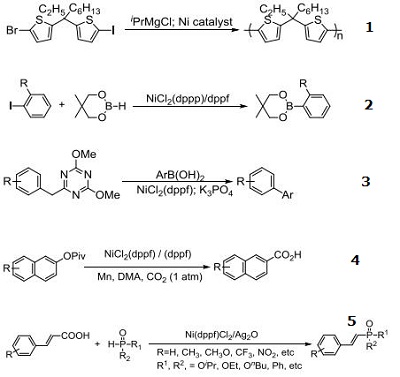| Identification | More | [Name]
BIS(1,5-CYCLOOCTADIENE)NICKEL(0) | [CAS]
1295-35-8 | [Synonyms]
BIS(1,5-CYCLOOCTADIENE)NICKEL(0)
NICKEL(COD)2
NI(COD)2
bis(1,5-cyclooctadiene)-nicke
Bis(1,5-cyclooctadiene)nickel
Bis(cyclooctadiene)nickel
Bis-1,5-cyclooctadienylnickel
Di(1,5-cyclooctadiene)nickel
Dicyclooctadiene nickel
Nickel dicyclooctadiene
Nickel, bis(1,5-cyclooctadiene)-
Bis(1,5-cyclooctadiene) Nickel(O)
Bis(1,5-cyclooctadiene)nickel (0) (C8H12)2Ni
Bis(1,5-cyclooctadiene)nickel(0),98+%
Bis(1,5-cyclooctadiene)nickel(0), 95+% | [EINECS(EC#)]
215-072-0 | [Molecular Formula]
C16H24Ni | [MDL Number]
MFCD00058902 | [Molecular Weight]
275.06 | [MOL File]
1295-35-8.mol |
| Chemical Properties | Back Directory | [Appearance]
Golden shiny crystalline powder | [Melting point ]
60 °C (dec.)(lit.)
| [storage temp. ]
0-6°C | [form ]
Shiny Crystalline Powder | [color ]
Gold | [Water Solubility ]
Soluble in benzene, toluene, terahydrofuran, ether, dimethyl formamide, hexamethylphosphoramide, N-methylpyrrolidinone. Insoluble in water. | [Sensitive ]
Air Sensitive | [Exposure limits]
NIOSH: IDLH 10 mg/m3; TWA 0.015 mg/m3 | [CAS DataBase Reference]
1295-35-8(CAS DataBase Reference) | [NIST Chemistry Reference]
Nickel, bis[(1,2,5,6-«eta»)-1,5-cyclooctadiene]-(1295-35-8) | [Storage Precautions]
Moisture sensitive;Light sensitive;Air sensitive | [EPA Substance Registry System]
1295-35-8(EPA Substance) |
| Safety Data | Back Directory | [Hazard Codes ]
F,Xn,T | [Risk Statements ]
R11:Highly Flammable.
R40:Limited evidence of a carcinogenic effect.
R45:May cause cancer. | [Safety Statements ]
S36/37:Wear suitable protective clothing and gloves .
S45:In case of accident or if you feel unwell, seek medical advice immediately (show label where possible) .
S16:Keep away from sources of ignition-No smoking .
S53:Avoid exposure-obtain special instruction before use . | [RIDADR ]
UN 1325 4.1/PG 2
| [WGK Germany ]
3
| [RTECS ]
QR6135000
| [TSCA ]
No | [HazardClass ]
4.2 | [PackingGroup ]
I | [HS Code ]
29319090 |
| Hazard Information | Back Directory | [General Description]
Yellow crystals or yellowish green solid. | [Reactivity Profile]
BIS(1,5-CYCLOOCTADIENE)NICKEL(1295-35-8) is extremely air and moisture sensitive. BIS(1,5-CYCLOOCTADIENE)NICKEL(1295-35-8) is sensitive to exposure to light. This compound is incompatible with oxidizing agents, acids and acid fumes. | [Air & Water Reactions]
This compound is extremely air and moisture sensitive. Decomposes in water | [Fire Hazard]
Flash point data for this chemical are not available. BIS(1,5-CYCLOOCTADIENE)NICKEL is probably combustible. | [Chemical Properties]
Golden shiny crystalline powder | [Uses]
Bis(1,5-cyclooctadiene)nickel(0) is used as a catalyst for the cycloaddition of 1,3-dienes and is used to catalyze the addition of allyl phenyl sulfide to alkynes leading to 1,4-dienes. Also, it is involved as a catalyst for asymmetric alpha-arylation and heteroarylation of ketones with chloroarenes, stereoselective borylative ketone-diene coupling, cycloaddition of benzamides with internal alkynes and methyl carboxylation of homopropargylic alcohols. | [Preparation]
Bis(1,5-cyclooctadiene)nickel(0) is prepared by reduction of anhydrous nickel(II) acetylacetonate in the presence of the diolefin:
Ni(acac)2 + 2 cod + 2 AlEt3 → Ni(cod)2 + 2 acacAlEt2 + C2H6 + C2H4
Ni(cod)2 is moderately soluble in several organic solvents. One or both 1,5-cyclooctadiene ligands are readily displaced by phosphines, phosphites, bipyridine, and isocyanides. If exposed to air, the solid oxidizes to nickel(II) oxide. As a result, this compound is generally handled in a glovebox. | [Reactions]
Catalyst for Grignard metathesis chain-growth polymerization of Poly(bithienylmethylene)s
Catalyst for neopentylglycolborylation of ortho-substituted aryl halides
Catalyst for Suzuki-Miyaura coupling reactions of heteroaryl ethers with arylboronic acids
Catalyst for carboxylation of naphthyl pivalates with CO2
Catalyst decarboxylative C?P cross-coupling of alkenyl acids with P(O)H compounds
Catalyst for direct amination of phenols via C–O Bond Activation using 2,4,6-Trichloro-1,3,5-triazine as reagent
Catalyst for conversion of aryl, heteroaryl and pharmaceutically relevant chlorides to the corresponding trifluoromethyl sulphides
Catalytic precursor for Suzuki–Miyaura cross-coupling reactions in water under very mild reaction conditions: (a) aryl–heteroaryl cross-couplings; (b) Hetero–heteroaryl cross-couplings

 | [Purification Methods]
It is available in sealed ampoules under N2. All procedures should be carried out in a dry box and in an atmosphere of N2 or Argon in subdued light because the complex is light and oxygen sensitive, and flammable. The solid is washed with dry Et2O (under Ar) and separates from toluene as yellow crystals. Filter this under Ar gas pressure, place the crystals in a container and dry under a vacuum of 0.01mm to remove adhered toluene, flush with Ar and seal them under Ar or N2 in glass ampoules. [Semmelhack Org Reactions 19 115 and 178 1972, Wilke et al. Justus Liebigs Ann Chem 699 1 1966, Wender & Jenkins J Am Chem Soc 111 6432 1989, Fieser & Fieser Reagents for Org Synth 4 33, 16 29, 17 32.] SUSPECTED CARCINOGEN. |
|
|